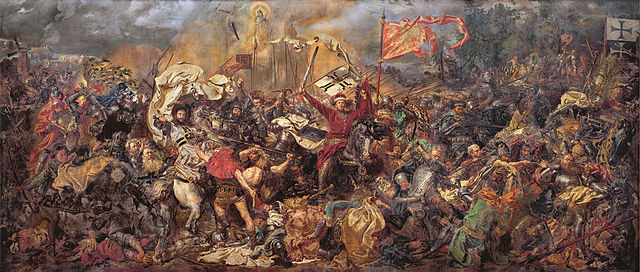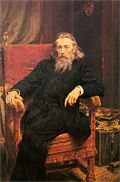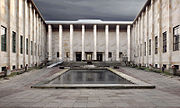
File:Grunwald bitwa.jpg

| |
This is a file from the Wikimedia Commons. Information from its description page there is shown below.
Commons is a freely licensed media file repository. You can help. |
Summary
| Artist |
|
|||||||||||||||||
| Title |
Deutsch: Schlacht bei Grunwald
English: Battle of Grunwald
Polski: Bitwa pod Grunwaldem
Беларуская (тарашкевіца): Грунвальдзкая бітва, карціна пэндзля Яна Матэйкі
Русский: Битва при Грюнвальде работы Яна Матейко
Lietuvių: Žalgirio mūšis Jano Mateikos paveikslas
|
|||||||||||||||||
| Date | 1878 | |||||||||||||||||
| Medium | oil on canvas | |||||||||||||||||
| Dimensions | 426 × 987 cm (167.7 × 388.6 in) | |||||||||||||||||
| Current location |
|
|||||||||||||||||
| Warsaw | ||||||||||||||||||
| Accession number | MP 443 | |||||||||||||||||
| Notes |
English: The Battle of Grunwald (or Battle of Tannenberg) took place on July 15 1410 between the Kingdom of Poland and the Grand Duchy of Lithuania on one side (estimated 39,000 troops), and the Teutonic Knights on the other (about 27,000 troops).
In the battle, the Teutonic Order was defeated and never recovered its former influence. The picture supposedly illustrates the moment when Ulrich von Jungingen, the 26th Grand Master of the Teutonic Order (left, dressed in white, with a black cross), is killed by infantry. Vytautas the Great is shown in triumphant position (centre, dressed in red). |
|||||||||||||||||
| Source/Photographer | www.info-poland.buffalo.edu | |||||||||||||||||
| Permission ( Reusing this file) |
Copyright expired | |||||||||||||||||
Licensing
The official position taken by the Wikimedia Foundation is that "faithful reproductions of two-dimensional public domain works of art are public domain, and that claims to the contrary represent an assault on the very concept of a public domain". For details, see Commons:When to use the PD-Art tag. |
|||||
| Annotations | This image is annotated: View the annotations at Commons |
File usage
About Schools Wikipedia
Schools Wikipedia was launched to make learning available to everyone. SOS Childrens Villages believes education is an important part of a child's life. That's why we ensure they receive nursery care as well as high-quality primary and secondary education. When they leave school, we support the children in our care as they progress to vocational training or higher education. There are many ways to help with SOS Childrens Villages.



